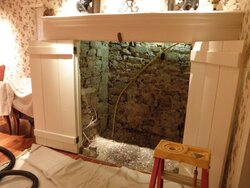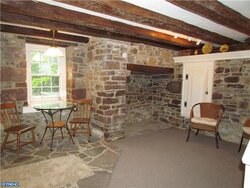We've all seen the "non-combustible" hearth requirements of some stoves, often spelled as, "masonry on dirt, with no wood framing anywhere below."
Okay, seems simple enough. In fact I've seen a few state things like, "the way a real fireplace is made." Okay...
My old kitchen fireplace is pretty typical of what you'll find in any 240 year old house around the mid-Atlantic region. The construction of these fireplaces should be held in the highest regard... after all someone had a 24/7 fire going in these for at least 100 years, and likely much longer, without ever having burned the house down.
Now, anyone who's spent any short time around old houses surely knows that the heavy lintels on these fireplaces were typically wood, and most have seen the wood doors mounted to wood casings that surround the openings of these stoves. No surprise...

What may surprise those who aren't familiar with old houses is that the floor/hearth of many of these fireplaces is actually supported by wood timber. In the case of mine, here's a photo of the basement / fireplace foundation:

Note that thing which looks like a fireplace, which it may have actually been prior to 1770. It's currently the foundation to my kitchen fireplace, directly above. Distance from the floor of my hearth down to those timbers is 26", and I find it difficult to imagine the heat radiating off the bottom of any wood stove is going to approach that of having fires built directly on the open hearth.
So, we have a stone hearth, consisting of 26" of stone, rubble, mud, horse hair, and even some straw, all set atop a wooden frame. Used as the primary place for cooking and much heat, for who even knows how many years since 1770, and no sign of any fire damage. So, I aks you this... what's with the "non-combustible" hearth requirements for some of the lesser expensive stoves? By these requirements, I would not be permitted to install one of those stoves in a fireplace that was used for open burning for probably 200 years longer than the life of the guy who wrote the requirements.
Okay, seems simple enough. In fact I've seen a few state things like, "the way a real fireplace is made." Okay...
My old kitchen fireplace is pretty typical of what you'll find in any 240 year old house around the mid-Atlantic region. The construction of these fireplaces should be held in the highest regard... after all someone had a 24/7 fire going in these for at least 100 years, and likely much longer, without ever having burned the house down.
Now, anyone who's spent any short time around old houses surely knows that the heavy lintels on these fireplaces were typically wood, and most have seen the wood doors mounted to wood casings that surround the openings of these stoves. No surprise...

What may surprise those who aren't familiar with old houses is that the floor/hearth of many of these fireplaces is actually supported by wood timber. In the case of mine, here's a photo of the basement / fireplace foundation:

Note that thing which looks like a fireplace, which it may have actually been prior to 1770. It's currently the foundation to my kitchen fireplace, directly above. Distance from the floor of my hearth down to those timbers is 26", and I find it difficult to imagine the heat radiating off the bottom of any wood stove is going to approach that of having fires built directly on the open hearth.
So, we have a stone hearth, consisting of 26" of stone, rubble, mud, horse hair, and even some straw, all set atop a wooden frame. Used as the primary place for cooking and much heat, for who even knows how many years since 1770, and no sign of any fire damage. So, I aks you this... what's with the "non-combustible" hearth requirements for some of the lesser expensive stoves? By these requirements, I would not be permitted to install one of those stoves in a fireplace that was used for open burning for probably 200 years longer than the life of the guy who wrote the requirements.
Last edited:

